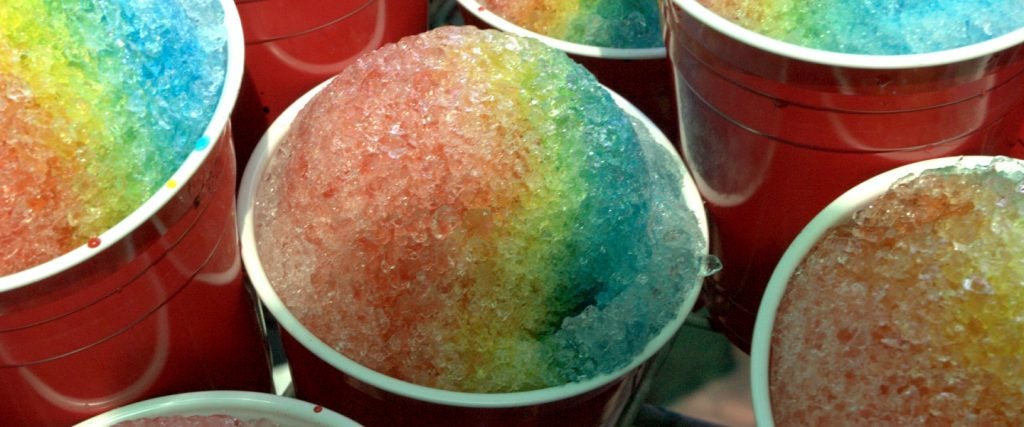Perhaps because the guy who drove an ice cream truck around my childhood neighborhood sold snow cones that tasted like cigarettes, I’ve never been the biggest fan of colorful, sweetened ice packed into a little paper cone. That said, I understand the appeal. Not only are snow cones one of the few dairy-free frozen treats available, but they’re not terribly unhealthy, either. But are they healthy in any real way?
Let’s take a look.
How Many Calories in a Snow Cone By the Numbers
According to Rio Syrup, one of the leading providers of snow cone syrup and supplies, the typical snow cone is six ounces of ice, topped with one ounce of syrup. Here’s how those ingredients shake down calorically.
The Ice: The good news is that ice, which makes up the lion’s share of your snow cone, has zero calories. Some go so far as to argue ice has negative calories because your body burns energy to melt it, but the bad news is that the spare calories you burn by eating ice aren’t going to make up for the next ingredient.
The Syrup: Whether your snow cone is pre-packaged or made on-site, its flavor is derived entirely from syrup that’s arguably more sugar than water. The primary ingredients of Rio’s snow cone syrup, for instance, are “mixture of high fructose corn syrup and granulated sugar.” This is why just one ounce of Rio’s syrup is 70 calories.
Assuming your snow cone is made with no more than a single ounce of that syrup, your snow cone is clocking in at 70 calories. If your friendly snow cone assembler tops you off with another ounce, add on another 70 calories. And these aren’t just any calories — these are calories that come from pure, unadulterated sugar. Per the American Heart Association, adult women should consume no more than 100 calories from sugar a day, and adult men should consume no more than 150.
You’re still better off, though, with a snow cone than almost everything else in that ice cream truck. For example, you’d need to eat about two snow cones to reach the total calories of an ice cream sandwich (180) and four snow cones to reach the caloric intake of an ice cream cone (290). You’re even better off with a snow cone than you are with one of those weird SpongeBob popsicle things (100 calories).
Calories in Your Favorite Big Brand Snow Cones
Despite just being ice and sugar, not all snow cones are made the same. Here’s the caloric breakdown of the most popular snow cone producers:
- Popsicle Snow Cone: 35 calories
- Jolly Rancher Snow Cone: 50 calories
- Blue Bunny Bubble Gum Snow Cone: 60 calories
Sure, they’re completely devoid of any nutrition, but you can’t do much better than a sub-100 calorie frozen treat on a hot day. Just, you know, don’t eat the whole pack.
How to Build a Low-Calorie Snow Cone
If you’re strictly against consuming nutrient-free calories from sugar but still want to slam a snow cone this summer, you’re in luck. There’s no shortage of sugar-free snow cone syrup at your disposal, not to mention a number of other more-natural ingredients you can substitute for a tasty snow cone.
On her website, A Modern Homestead, Victoria Pruett outlines a simple three-step recipe for low-calorie snow cone syrup that uses sugar derived from fruit.
Step 1: After deciding which fruit you want to use for flavors (Pruett uses strawberry, mango and kiwi), mash each into a sauce pan over medium heat. You can add sugar — or a more natural sweetener like honey, maple syrup or agave — if you want to up the syrup’s overall sweetness.
Step 2: While whisking, bring the ingredients to a simmer for five to ten minutes until they thicken into a syrup-like consistency. If it gets too thick, Pruett explains, you can add water.
Step 3: Pour the syrup into a bowl (straining seeds, if needed), then place the bowl in the fridge for a few hours to cool. Once it’s chilled, pour the syrup into a squeeze bottle to easily dress your snow cornes.
A natural, fruit-flavored snow cone is exactly the kind of refreshing summer treat the chain-smoking ice cream man motoring around my neighborhood would have hated. But then again, maybe he was just saving us from the empty calories.

